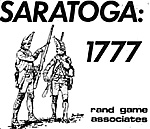
SARATOGA: 1777 is the second game in Vol. I of Rand Game Associates Command Series. The components are of the same design and quality as those of Lee vs. Meade so there is no need to cover that ground again.
Movement is carried out by the strategic point system a la Quebec 1759. The British are based at St. Johns, Canada and may move down Lake Champlain and Lake George to the Hudson and Albany, or down the St. Lawrence and Lake Ontario to Ft. Oswego and then across to Albany. The Americans appear at various points on the map throughout the game and must attempt to keep the British out of Albany and if possible Ft. George. Victory is determined by possession of Ticonderoga, Ft. George and Albany as well as unit losses. Draws are possible. The British should take Ticonderoga and Ft. George easily, so the outcome usually depends on attrition and the fate of Albany.
SEQUENCE OF PLAY: Each turn consists of five phases; Reinforcement, Normal Movement, Rapid Movement, Combat and Entrenchment. Most British units may move one point per turn with some special units having the possibility of rapid marching an extra point. All American units except artillery may automatically rapid march, so the Americans are much more manuverable than the British. The Rebels also have the advantage of being able to move on trails which no British unit other than the Iriquois may do; there are only three points connected by trail but they are on the flank of the main British advance route and thus very useful.
SUPPLY: Units must be within nine points of a supply source to be supplied. Unsupplied units function normally, but are eliminated if unsupplied for three consecutive turns. St. Johns, Ticonderoga and Ft. Oswego are the main British supply sources although there are some special points which supply British units on or within one point of them. American units are supplied from several points between Albany and Bennington. No American units are in supply north of Ft. Crown Point.
COMBAT: Combat occurs when units of both sides occupy the same point. The basic combat system is extremely simple on the face of it. You simply take the total number of your units ignoring combat factors and divide by three rounding down to compute enemy losses. However all sorts of little rules are thrown in about when units must attack, retreats and British rallying. In the end the basic system is at least as complicated as the optional.
The optional system makes use of the combat factors printed on the units and has the considerable advantage of not being so cut and dried. Combat factors are totaled for attacker and defender and odds figured. A die is rolled and the outcome is either attacker winner/defender loser, stalemate or defender winner/ attacker loser.
Each side then rolls on one of three Loss Percentage Charts depending on whether you won, lost or stalemated. You lose the resulting percentage of your opponents combat factor total. For example lets say 50 British factors attack 30 American. A 5 is rolled which at 1-1 odds results in defender wins/attacker loses. The American rolls on the LPC for winners and say the result is 33 1/3%. Thus the Americans must lose this percentage of the British total of 50, or 16 2/3 rounded up to 17 combat factors. The British player rolls on the LPC for losers and obtains a result of 50%. He must lose 1/2 of the American factors or 15. Additions and subtractions to the LPC die roll are possible if 2 or 3 to 1 odds exist.
The higher the odds the better your chances, but you can win the battle and still end up losing the most factors, and viceversa. Forts and entrenchments add to the defense and may require the enemy to have artillery present in order to attack.
Simple
This game is extremely simple. Indeed many people may find it too simple. Movement routes are limited and obvious (as they actually were) and there is very little scope for fancy manuvering. The British start with overwhelming numbers and the Americans must delay and generally avoid a fight. The British generally send the bulk of their forces down the Lake Champlain-Hudson River route while sending diversionary forces via Ft. Oswego.
The Americans pretty much have to fall back to the Bennington area before they have enough units to contest the British advance. At this point the Americans are on interior lines and their movement bonus gives them a good chance to stymie the British and send a couple of units via the trails to harass the British supply line. Now the battling starts in earnest and what happens depends a lot on the die. And this is not a bad thing. The optional combat system keeps the game from becoming horribly predictable. All sorts of interesting little things can happen once the log jam begins to break, and as long as both players can contrive to defend at no worse than 1 to 1, unpredictable things will usually happen. If the die rolls average out the game will usually go down to the wire with either side narrowly achieving victory or a draw. SARATOGA: 1777 is not a great game, but it does have the virtues of being simple, fast moving and often surprising. All in all, it's kind of fun.
Back to Table of Contents -- Panzerfaust #63
To Panzerfaust/Campaign List of Issues
Back to MagWeb Master Magazine List
© Copyright 1974 by Donald S. Lowry
This article appears in MagWeb (Magazine Web) on the Internet World Wide Web. Other military history articles and gaming articles are available at http://www.magweb.com